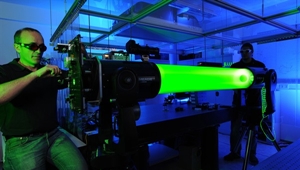Space debris in the spotlight
21 Feb 2012
Every year, the number of small items of debris in space rises by tens of thousands. This number is currently based on estimates, as it has not been possible to track space debris accurately. Researchers at the German Aerospace Center (Deutsches Zentrum für Luft- und Raumfahrt; DLR) are developing an optical observation system with a powerful laser, the pulses from which can detect particles only a few centimetres in diameter and allow determination of their orbits.
 |
| DLR and the Laser Station in Graz provide Europe's first ever demonstration of laser location |
The concept was tested for the first time in January 2012, in collaboration with the Laser Station in the Austrian city of Graz. This is the first time that the orbits of spent launcher components have been measured using a laser in Europe. In the future, an even more powerful laser will be capable of deflecting these particles out of their orbits, causing them to incinerate as they re-enter Earth's atmosphere.
The laser station in Graz is a part of the Space Research Institute (Institut für Weltraumforschung; IWF) of the Austrian Academy of Sciences (Österreichischen Akademie der Wissenschaften; ÖAW), and the laser beam it sent up into space was able to detect more than 20 different launcher components at distances of 500 to 1800 kilometres.
This search for space debris was based on calculations performed by researchers at DLR Stuttgart, and involved detecting them and measuring their distance from Earth.
"This provides us with confirmation that our idea really works," explained Adolf Giesen, Director of the DLR Institute of Technical Physics. Even though the space debris tracked during this test was several metres across in size, the success of the experiment is an important step forward for the researchers.
"At present, we are developing and building a system to detect space debris. This will incorporate a laser with higher pulse energy, enabling the detection of significantly smaller items. When this becomes operational, it should be possible to locate objects measuring just 10 centimetres across."
The need to track space debris, even down to sizes of just one centimetre, and to calculate the orbits of that debris, is growing with each passing year. Decommissioned satellites or spent upper stages of launch vehicles can collide with one another and disintegrate into smaller pieces. When two satellites collide, such as in the event involving Iridium 33 and Kosmos-2251 in February 2009, a large amount of space debris is generated (See: Debris from satellites' collision possibly seen in Texas skies)
There are so many pieces of debris, both large and small, in orbit at altitudes between 800 and 1400 kilometres that active satellites run the risk of getting damaged by it.
"In the event of a collision, even an item with a diameter of one centimetre can completely destroy a satellite," explains Wolfgang Riede, Head of the Active Optical Systems Department at the DLR Institute of Technical Physics. Space debris orbits at roughly eight kilometres per second, so if it collides with an object travelling in the opposite direction, the relative impact speed can usually be as high as 14 kilometres per second. Evasive manoeuvres are only effective if the positions of the debris can be calculated with great precision.
Conventional radar and telescope observations are only able to accomplish this to a limited extent; for this reason, a number of unnecessary avoidance manoeuvres, each consuming a great deal of propellant, must be performed. Even avoidable collisions are a potential consequence of imprecise orbital data; this was the case in February 2009, when the necessary change in orbit was not performed.
The physicists at DLR Stuttgart have set themselves an ambitious target to be reached by 2014. They are currently designing a transceiver unit and a laser that will send 1000 pulses per second from Earth into space and then record the light reflected from space debris at very high resolution.
"We will send high-intensity pulses of laser light up into space, and then quite literally count the individual photons reflected back to us," explains Institute Director Giesen.
The surfaces of launcher and satellite debris are very difficult to detect, as they range from matte black to highly reflective. Not only that, but the researchers must also take into account the perturbing influence of the atmosphere. Nevertheless, the small number of returning photons is still enough to determine the range, direction of travel and position of items of space debris with great precision.
Transferred to the ground, it is difficult to find a suitable example to demonstrate the remarkable level of precision; it will be something akin to being able to tell which hand a person in the Baltic Sea is holding up, as viewed from the site of the future observation station in Stuttgart.
After building up a catalogue containing as many of these small debris items as possible and recording their current orbits, the next step - that of reducing the amount of space debris - can follow.
"If the amount of space debris continues to increase, we will eventually cease to be able to operate satellites in the more densely populated orbits," states Giesen. "Their service life would be greatly shortened."
One solution to this could use extremely powerful lasers. When such a laser is directed onto an item of debris, material would evaporate from its surface, reducing its velocity. Even if that retardation only amounted to 200 metres per second, it would be sufficient to ensure the orbit's decay in the following years, and the debris would eventually burn up upon entry to the denser layers of Earth's atmosphere. Giesen estimates that this method could become operational in about 10 years.
"We would be continuously reducing the amount of debris in space," he explains. "If this fails, there will be so much space debris in Earth orbit 20 to 30 years from now that vitally important near-Earth orbits will become unusable."




















.jpg)









